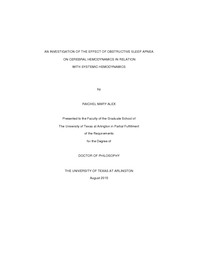| dc.description.abstract | Obstructive Sleep Apnea (OSA) is a major sleep disorder affecting approximately 18 million adults in the US. Recent studies have observed cognitive impairments and brain structural changes in OSA subjects where these deficits were related to peripheral hypoxia and sleep fragmentation. Nonetheless, underlying cerebral hemodynamics and cerebral oxygenation might play an important role in the development of these impairments. Hence, in this study it is hypothesized that 1) OSA induces significant variations in cerebral hemodynamics, and 2) level of variations in cerebral hemodynamics can be related to the changes in systemic hemodynamics. To test these hypotheses, 8 hours of nocturnal polysomnography was conducted on 11 OSA subjects (6 Males, 5 Females; Age: 54.27±6.23 years, BMI:34.95±7.06kg/m2, AHI: 57.39±28.43) who have been positively diagnosed of having OSA. Systemic hemodynamics [arterial blood pressure (BP), arterial oxygen saturation (SaO2), end tidal CO2 concentration (ETCO2)] and cerebral hemodynamics [cerebral blood flow velocity (CBFV) and brain tissue oxygenation] were recorded concurrently with polysomnography. OSA elicited an average increase of 41.98±1.88% (Mean±SEM) in mean CBFV compared to its value prior to the start of OSA. The rate of rise in mean CBFV was observed to be 0.56±0.03 cm/s2. Additionally, OSA induced an average drop of -2.03±0.14μM/L in brain oxy hemoglobin concentration. All the metrics derived from CBFV and brain oxygenation data (except the rate of rise in diastolic and mean CBFV and level of drop in oxy hemoglobin) were significantly correlated with the OSA duration (p<0.001). However, there was no correlation of cerebral hemodynamics with AHI, the OSA severity index.Further, features derived from cerebral hemodynamics showed a significant correlation with one or more of their systemic counterparts (p<0.03). Average time delays of 6.20±0.45s, 3.98±0.27s and 6.05±0.95s were observed between changes in systolic BP vs systolic CBFV, diastolic BP vs diastolic CBFV and SaO2 vs brain oxy hemoglobin concentration, respectively. Moreover, mathematical modelling of dynamic cerebral autoregulation using autoregressive moving average model indicated that a second order system can be used to predict BP related dynamic changes in CBFV during OSA. Hence this study suggests that OSA induces significant variations in cerebral hemodynamics which can be related to the changes in systemic hemodynamics. Furthermore, inclusion of OSA duration in addition to AHI might be beneficial while assessing the severity of OSA. | en_US |

